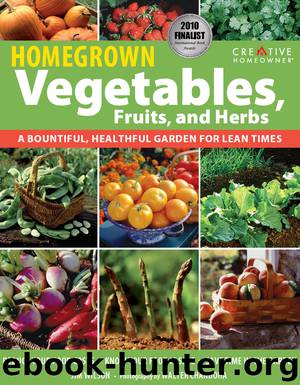Homegrown Vegetables, Fruits & Herbs by Walter Chandoha

Author:Walter Chandoha
Language: eng
Format: epub
Publisher: Fox Chapel Publishing
ESSENTIAL STATS
Life span
Biennial, grown as a cool-weather annual. Collard seeds sprout quickly and within 80 days will produce the first of many meals.
Grow from
Direct seeding.
When to plant
In Zones 3 through 5 sow seeds in spring as soon as the soil is dry enough to work. Hot weather will damage plants, so harvest them and plant seeds again in late summer for a fall harvest. Farther south, wait until August 15 or later before direct seeding. Sow seeds 3 to 6 inches apart to reduce the chore of thinning.
Best site
Collards are not wimpy vegetables; they will thrive wherever planted, if you start them within the window of planting time for your hardiness zone. In the Deep South and warm western areas, afternoon shade will help collards sail through the last days of hot weather before entering the cool, moist days of fall and early winter.
How much to plant
Southerners rely so much on collards that it is not unusual to see a 30-foot row planted to provide for two people—12 to 15 collard plants would fit into a row of that length, if the plants were staggered. Collard leaves will “hold” on the plant for weeks after reaching full size, retaining flavor and tenderness.
Continuing care
Not much attention is required, just thinning and frequent enough watering to avoid serious wilting. Avoid fertilizing fall-planted collards after the first light frost. The nitrogen fraction could make the plants susceptible to freezing.
Harvesting
Nip off the lower leaves a few at a time to avoid shocking the plants. The upper leaves will continue to extract energy from the sun. After several weeks, collards typically show a foot or so of bare central stem, but they keep on ticking. Leaves harvested during hot weather should be placed in a plastic bag and stored in the vegetable keeper. After a week or two, they will be sweeter when cooked.
Insect, pest, and plant diseases
Collards are susceptible to the same diseases and insects as cabbages. Cabbageworm infestations can be particularly bad during the waning warm days of late summer. Keep Bt bacteria sprays handy.
Download
This site does not store any files on its server. We only index and link to content provided by other sites. Please contact the content providers to delete copyright contents if any and email us, we'll remove relevant links or contents immediately.
Turbulence by E. J. Noyes(7033)
The Thirst by Nesbo Jo(5779)
Gerald's Game by Stephen King(3913)
Be in a Treehouse by Pete Nelson(3207)
Marijuana Grower's Handbook by Ed Rosenthal(3114)
The Sprouting Book by Ann Wigmore(3050)
The Red Files by Lee Winter(2909)
The Remains of the Day by Kazuo Ishiguro(2614)
Sharp Objects: A Novel by Gillian Flynn(2440)
Christian (The Protectors Book 1) by L. Ann Marie(2393)
Organic Mushroom Farming and Mycoremediation by Tradd Cotter(2304)
The Culinary Herbal by Susan Belsinger(2056)
Stone Building by Kevin Gardner(1993)
The Starter Garden Handbook by Alice Mary Alvrez(1922)
Lilac Girls by Martha Hall Kelly(1868)
The Unlikely Pilgrimage of Harold Fry by Rachel Joyce(1834)
The Lean Farm Guide to Growing Vegetables: More In-Depth Lean Techniques for Efficient Organic Production by Ben Hartman(1782)
Urban Farming by Thomas Fox(1748)
Backyard Woodland by Josh VanBrakle(1586)
